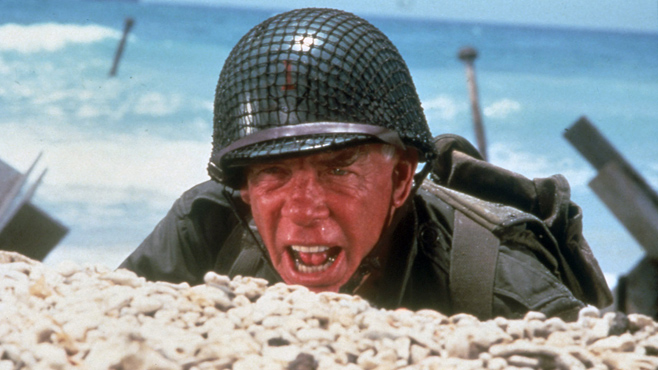
Samuel Fuller (1912-1997) carried in him the very spirit of American independent filmmaking. A longtime New Yorker and lifelong workhorse he began as a newspaper copyboy at age 12, was a crime reporter by 17, wrote his first of a dozen pulp novels at 22 – with titles like Test Tube Baby and Burn Baby Burn – his first of many screenplays at 24, fought in the United States Infantry in the Second World War, and began his directorial career – which would total 26 films across four decades – in 1949 with the western I Shot Jesse James.
A maverick in the confines of b-production his work spanned genres and styles but often sprang from the worlds of pulp violence, tabloid expose, and social protest, drawing from his journalistic sense and experiences on the crime beat, as well as war stories, which he would explore in films set in Europe, Korea, and Vietnam.
Characterized by the swaggering bravado of his dialogue and characters, (and the quirk of always having his good guys smoke cigars – and with Fuller there are always good guys) and visual flourishes that amount to battering his audience, Fuller’s style conveyed a strong sense of justice derived from often contradictory seeming moral convictions, a strong American patriotism and stronger anti-racism, and vision of American multiculturalism, an anti-authoritarian streak and a love of the US military, progressive protrayals of women and a pervasive machismo – all of which incurring slander and wild condemnations from one dimensional thinkers on both the left and right – usually a sign of doing something right.
Fuller’s legacy is not only left in his beloved films, but in a generation or two of filmmakers deeply in his debt, from the French New Wave directors credited with revitalizing cinema in the mid-20th century who considered Fuller among the best American filmmakers, to the countless auteurs to follow who have cited Fuller as a mentor figure and drawn from his work in their own – Scorcese using camera techniques from The Steel Helmet in Raging Bull, Paul Thomas Anderson using the same film’s opening shot for his own in The Master, and Jean-Luc Godard casting Fuller in Pierrot Le Fou as a mouthpiece for that much sought nature of cinema itself: Film is like a battleground. There’s love, hate, action, violence, death, in one word, emotion.
These are the 10 films of Samuel Fuller that you need to see.
1. The Steel Helmet (1951)
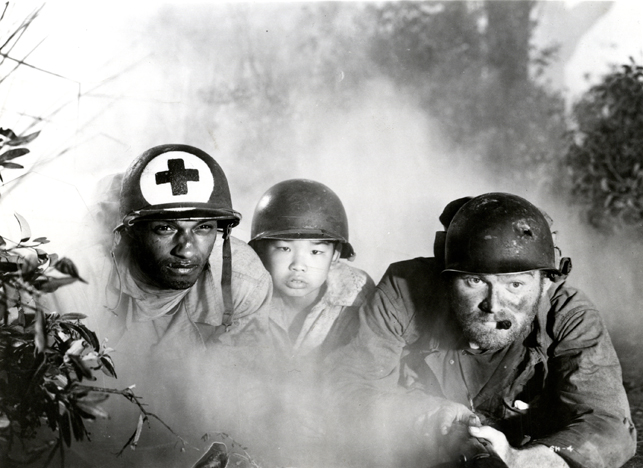
“All war stories are told by survivors.”
After directing two westerns for producer Carl Hittleman, I Shot Jesse James (1949) and The Baron of Arizona (1950), Fuller self-produced The Steel Helmet, a Korean war story reportedly written in one week and shot in 10 days on a $100,000 budget that would propel him to b-movie success and remains among the most loved and most influential of Fuller’s filmography.
The story of an American prisoner of war (Gene Evans) miraculously surviving point blank execution by a bullet that enters his helmet circles round his head and exits back out the front it follows his survival behind enemy lines with the help of an orphaned South Korean boy (William Chun) and the ragtag remnants of an American squad on its way to set up an observation post in a nearby Buddhist temple.
Fuller made the most of his production constraints with a tense, claustrophobic, and disorienting portrait of combat in dense foliage and gunfire haze. Life is cheap to Sergeant Zack (Evans), a man both hardened and broken by combat, driven more by survival instinct and balls than any standard operating procedure or heroic ideals of military service, for who putting yourself in the line of fire is called doing what you’re paid to do and a dead comrade’s worth is no more than the boots or cigars he leaves on his corpse.
But it’s also a film shot through with a humanistic spirit, as Zack develops a reluctant big brotherly relationship to the Korean boy he nicknames ‘Short Round’ (Chun), and an emphasis on the individuality of the soldiers who represent a diverse racial background and carry each their own personality quirks – the strangest being the conscious-objector priest and organist who lugs his portable keyboard through combat and worse – rather than portraying the unit as a faceless or racially homogenous embodiment of military force.
Though not his first directorial effort, the film introduced the world to Fuller’s unique brand of socially conscious bombast, breaking material still hot – the first American film on the Korean war, the first film to speak of American Japanese internment camps during WW2 – and invoking labels pro-communist, and treasonously anti-American for the same film elsewhere called a right wing fantasy.
2. Park Row (1952)
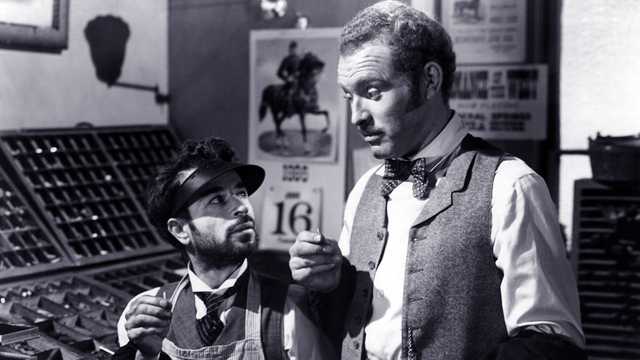
Dedicated to American Journalism Fuller’s personal favorite of his many films turns to his first love and first life in the underdog drama of New York’s historical Park Row newspaper district.
Following renegade newsman Phineas Mitchell’s (Gene Evans) firing from the Row’s monolithic paper ‘The Star’ for activities in protest of their influencing a death sentence in a highly public trial, he finds himself drinking in a bar of Park Row’s downcast and struggling set, other Star firees and amatures still looking for a break, and quickly inspires the overnight creation of The Globe, a new independent peoples’ paper in the print shop of Charles A. Leach (Forrest Taylor) getting together a ragtag crew and printing their first issue that morning, the leading story being the daring Brooklyn bridge jump of one of the bar’s drunks, and the injustice of his subsequent arrest – set up, of course, by Mitchell himself.
Much to the surprise and chagrin of The Star’s Ayn Rand/Cruella de Vil empress Charity Hackett (Mary Welch) these antics work, and the overnight creation of her cast off troublemakers quickly becomes a stick in the eye of her paper – especially once warring over the construction of the Statue of Liberty’s pedestal, an issue symbolic as it is historic, in playing to Fuller’s strongest patriotic sentiments, a defense of the democratic free press.
Park Row is a celebration of both the high and low of newspaper journalism, the yellow tactics used to push papers, and the noble ideals of Truth, Justice, and innovation represented by the photographic pantheon of Fuller’s journalistic heroes hung on The Globe’s wall, and is in this way too a kind of close-up on 19th century print and editorial technique and process both pre and post linograph machine, showing the excitement and enterprise of the daily news cycle.
3. Underworld, USA (1961)
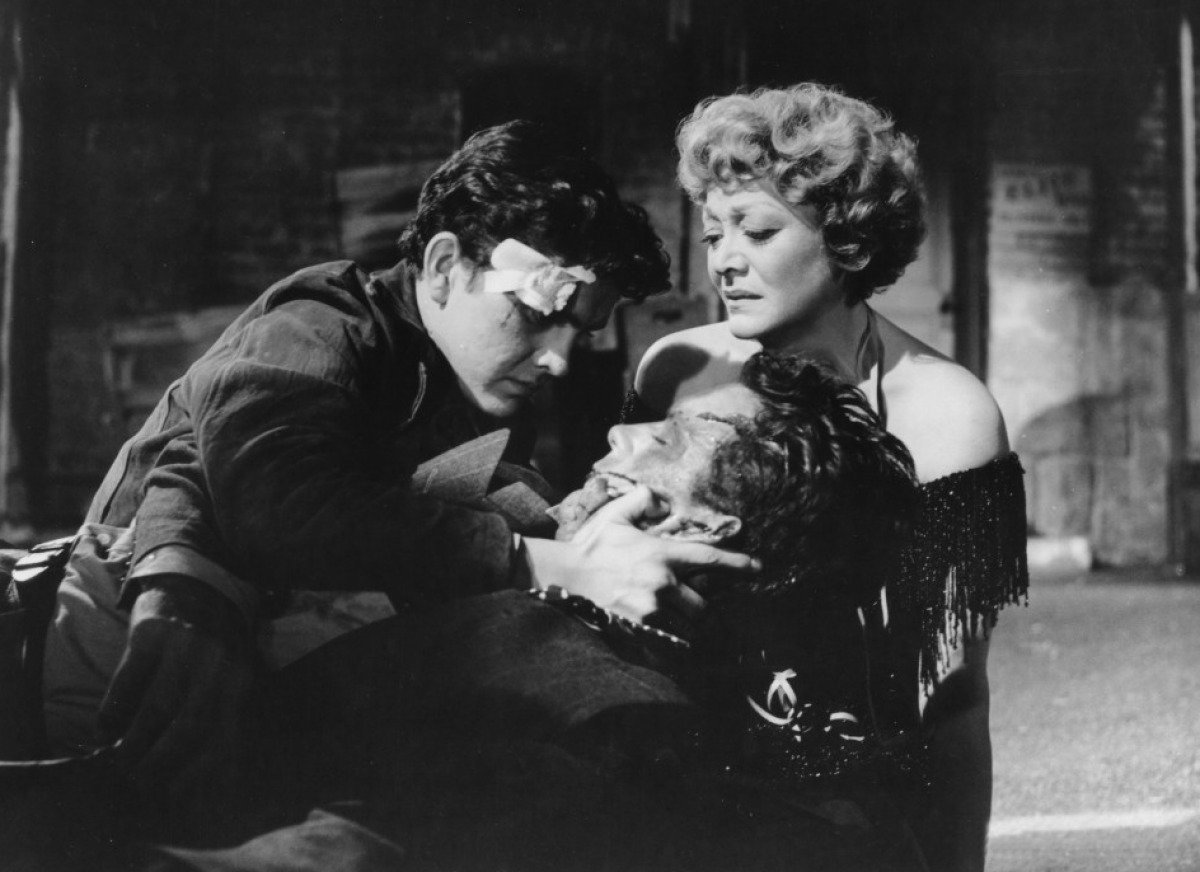
A pulp revenge thriller admirable for its single minded simplicity Underworld, USA is a film of pure blistering hatred as Tolly Devlin (Cliff Robertson) – 14 year old witness to the murder of his father by four mafiosos – devotes his life to tracking them down and one by one bringing them to justice, either by law or by his own hand.
A street thief from the moment we meet him, (played in youth by David Kent) Tolly is caught in a burglary in his twenties and sent to the prison where Vic Ferrar (Peter Brocco), the only known assailant of Tolly’s father, is being privately held for his failing condition. Tolly learning of this quickly gets a job in the infirmary to get close to Tolly and shake the names of the other three killers out of him. Back on the street Tolly sees those three men staring at him from the front page of a newspaper, the three kingpins of New York crime – Gela, narcotics (Paul Dubov), Gunther, labor, (Gerald Milton), and Smith, prostitution (Allan Gruener) – all working beneath the underworld’s chief of staff Earl Conners (Robert Emhardt).
Doing what it takes to get close to these men, each better protected than the president of the United States, Tolly forces his way into the mob and rises through the ranks on loyalty and expertise. Along the way Tolly posing as a narco cop, enlists the help of Cuddles (Dolores Dorn), one of Gela’s girls, and reluctantly works alongside FBI man John Driscoll (Larry Gates), the arresting officer of his father’s murder who ten years ago he refused to help on account of not being a Fink. Meanwhile Tolly endangers and blows off the good intentions of Sandy (Beatrice Kay), an old friend of Tolly’s father and a mother figure to Tolly from youth as the only one who ever really cared for him.
Unfolding pretty much exactly as you expect, Underworld, USA is not a subtle film, but one with a strong sense of driving force and carried by the pitch black spirit of Robertson’s Tolly Devlin and near-apocalyptic tabloid hysteria of crime run amok drawing from a series of Boston Globe articles of the film’s own name by Joseph F. Dinneen.
4. Pickup on South Street (1953)
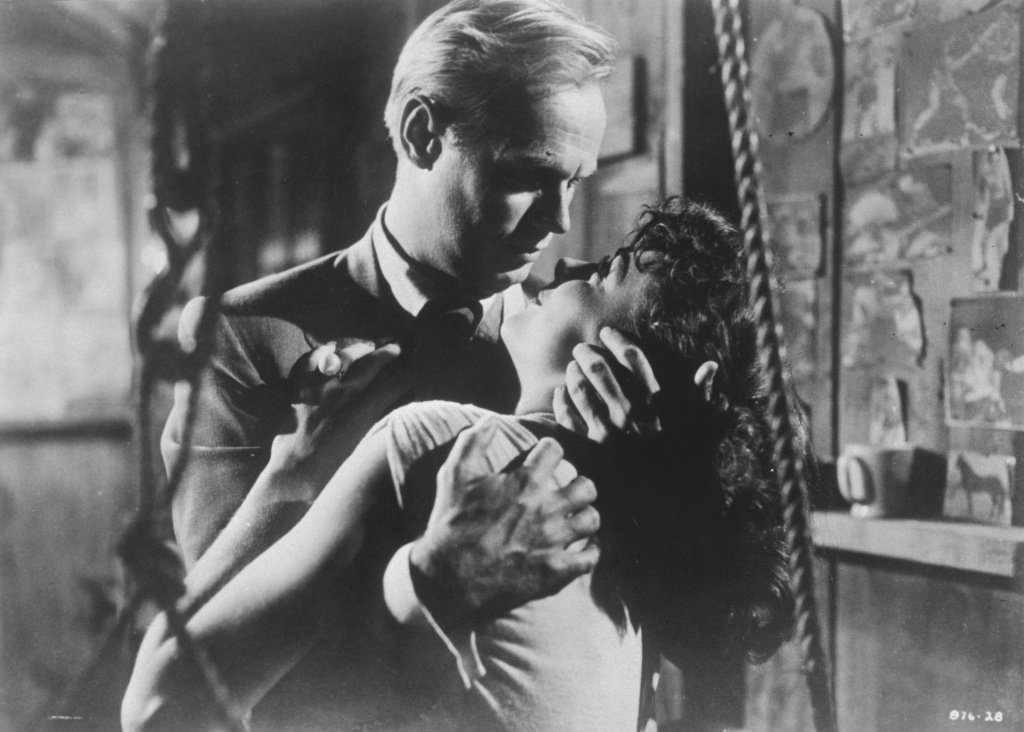
Pickup on South Street marks Fuller’s own part of the red scare as a cold war thriller that pits the New York City underworld against the work of communist spies. Pickpocket Skip McCoy (Richard Widmark) gets inadvertently wrapped up in the game of espionage picking the wallet of communist bagwoman Candy (Jean Peters) on the train, unaware of her carrying a stolen government microfilm and being smuggled out the country by her ex-boyfriend Joey (Richard Kiley) who has called on Candy for a favor unaware, and who is likewise unaware he has been under surveillance by federal agent Zara (Wilis Bouchey) who following Candy is led to the trail of Skip McCoy.
This sets in motion a kind of underworld scramble, the cops, the commies, and Candy all looking for Skip and the microfilm, trying to catch up to and play off of what one another knows, and chasing down a chain of underworld informers leading to stoolie Moe (Thelma Ritter) the fast talking information trader who can identify Skip from among the city’s many pickpockets by a few short questions on the technique he used to pick the wallet, and in this way circles all film around our elusive antihero Skip who always stays one step ahead of the audience and others, trying to play both sides in his favor.
The pickpocket scenes, shot in a series of extreme closeups – the fingers, the wallets, the expert movements made – intercut with Skip facing down his mark in an intense psychological exchange that seem (unacknowledged) to have provided the basis for French auteur Robert Bresson’s own masterpiece Pickpocket (1959) which, emptied of all the pulp tension of Fuller’s work, reproduces these scenes almost directly.
5. Forty Guns (1957)
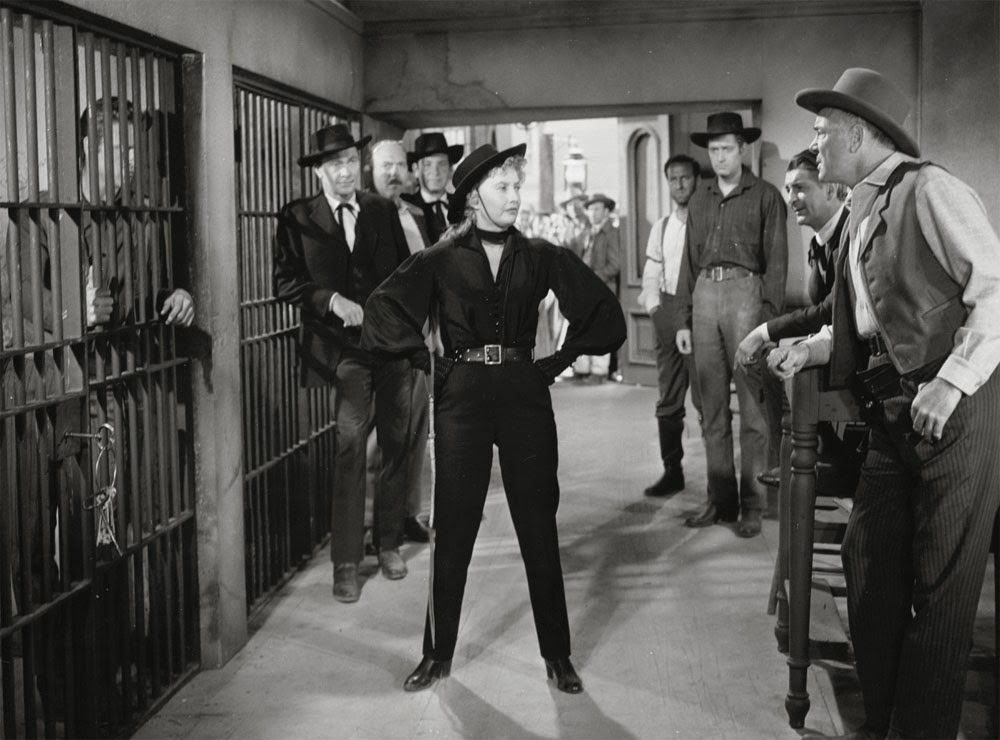
Forty Guns is just one of Fuller’s handful of westerns, but as if to outdo Nicholas Ray’s tough-chick western Johnny Guitar (1954) which saw black-clad Joan Crawford packing a pistol gives Barbara Stanwyck’s Jessica Drummond a black-hat getup fit for only the baddest, an iron-grip on all of the Cochise county, and a gang of forty hired killers, forty men in her charge, stampeding behind her in the film opening’s forty-one horse tear across the plains like the run of motorcycle gang.
A wealthy rancher with defacto rule of the territory Drummond and her goons who ransack towns like vikings go unchallenged until the the arrival of bounty hunter Griff Bonnell (Barry Sullivan) and his brothers Wes (Gene Barry) and Chico (Robert Dix). A man of ideals about law and order Griff is an ex-gunslinger given up his right to kill, come to the town of Tombstone to peaceably take in a Howard Swain (Chuck Robeson), one of Drummond’s men with a warrant out for mail theft, but arrives to find the town living in the fear of Drummond’s forty and has to step in with violence when Brockie (John Ericson), Jessica’s drunken brother, shoots the enfeebled Marshall Chisholm (Hank Worden). And working to take care of Swain Griff invariably gets caught up in the Drummond business, while Wes tries to settle down with the beautiful gunsmith Louvenia (Eve Brent) and take place of the town Marshall, and both brothers try to convince Chico not to get caught as they did in a world of violence.
But while Griff and Jessica begin an antagonistic flirtation – Griff visiting Jessica at her villainous manor where she sits at the head of table forty-men long and takes dinner with her killers nightly – violence continues to escalate and puts Griff in the middle, with both his brothers standing target of the gang’s next outburst.